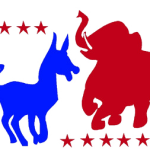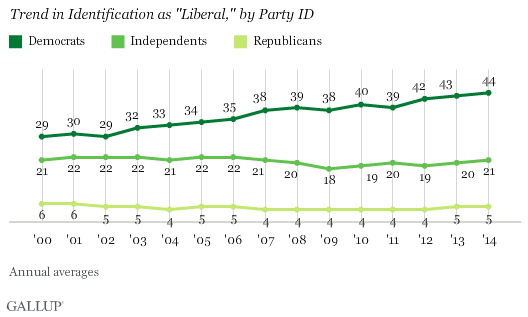Gallup reports that c onservatives continued to outnumber moderates and liberals in the U.S. population in 2014, as they have since 2009. However, their 14-percentage-point edge over liberals last year, 38% vs. 24%, is the smallest in Gallup’s trends since 1992. The percentage of U.S. adults identifying themselves as politically conservative in 2014 was unchanged from 2013, as was the percentage of moderates, at 34%, while the percentage considering themselves liberal rose a percentage point for the third straight year.
onservatives continued to outnumber moderates and liberals in the U.S. population in 2014, as they have since 2009. However, their 14-percentage-point edge over liberals last year, 38% vs. 24%, is the smallest in Gallup’s trends since 1992. The percentage of U.S. adults identifying themselves as politically conservative in 2014 was unchanged from 2013, as was the percentage of moderates, at 34%, while the percentage considering themselves liberal rose a percentage point for the third straight year.

When Gallup initiated this measure of self-identified political ideology in 1992, the largest group of Americans called themselves moderate, while slightly more than one-third identified as conservative and fewer than one in five as liberal. The conservative-liberal gap at that time was 19 points, and by 1996 it had widened to 22 points, its highest across the trend. Since then, the liberal percentage has swelled and the percentage of moderates has shrunk from 40% to 34%.
These results are based on combined data from Gallup’s standalone surveys of U.S. adults, totaling between 16,000 and 45,000 interviews for each year.
Political Polarization Inched Further Ahead in 2014
The one-point uptick in the percentage liberal in 2014 stems from one-point increases in liberal self-identification among both independents and Democrats. The small percentage of Republicans identifying as liberals stayed the same. Longer term, since 2000, all of the rise in liberalism on this measure is owing to Democrats.

At the same time, Republicans’ strong tendency to identify with the conservative moniker stayed the same in 2014 at 70%, just under the 73% high point reached in 2012. The percentage of Republicans who consider themselves conservative remains slightly higher today than it was through the mid-2000s,and the pattern is nearly the same with independents. At the same time, fewer Democrats call themselves conservative compared with a decade ago.

Over time, the growth of liberals and conservatives has come at the expense of moderates, a group that has been shrinking as a proportion of every party group, but particularly Republicans and Democrats. While moderates gained a point back among independents and Republicans in 2014, they remain below their recent highs.

As evident in a thorough review of these trends in 2014, moderates still represent the largest segment of independents. Since 2010, Democrats have been more likely to identify as liberals than as moderates. Conservatives continue to dominate Republicans’ ranks.
Bottom Line
Over the past 22 years, Americans’ ideological bent, or at least their willingness to associate with certain labels, has changed in subtle ways. Although the “liberal” moniker remains the least favorite, it has enjoyed the most growth, while “conservative” is up slightly and “moderate” has waned. But to a large extent, these changes reflect opposing ideological shifts within the parties, not national trends. That helps explain how there could be a record proportion of liberals at a time when Democratic identification was at a long-term low. Likewise, even though 2014 was a strong election year for the Republican Party, Gallup found no increase in conservatism in 2014 compared with 2013. All of this happened at the same time that political independence was peaking, which is to say that ideological polarization and the strength of the two major parties don’t necessarily go hand in hand. In fact, one may undermine the other.



The term ‘conservative’ currently has a double inference – ‘normal conservative’ and ‘tea-party conservative’. This poll lumps both together. The same logic is also applied to the ‘liberals’ label.
I wonder how many people on both sides are now calling themselves ‘moderates’ because they don’t want to be affiliated with the ‘ultra’ faction in both parties.
I see a lot of people call themselves “conservative” who support giant government programs of various types. Most of those in office who say they are conservative are not limited government, Constitution following people.
Think of how free and prosperous we would all be if that were to change.
Of course, we would have to end the massive subsidies (i.e. tax credits) that many businesses currently get, we would have to end the regulatory structure that serves to limit competition in the private sector, and we would need to bring our military home from its current role as world policeman. We would also end up firing a lot of people who work for the government at all levels – and we would need to reform the currency back to a gold or gold/silver or some sort of commodity based standard. A few years along, and we would be the strongest, most free and best liked nation on the planet (again) instead of the fascist police state we are becoming.
I can dream….